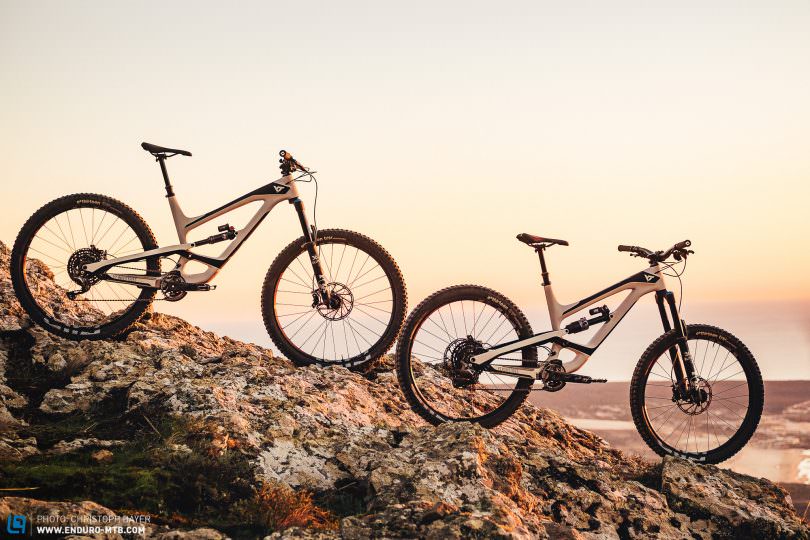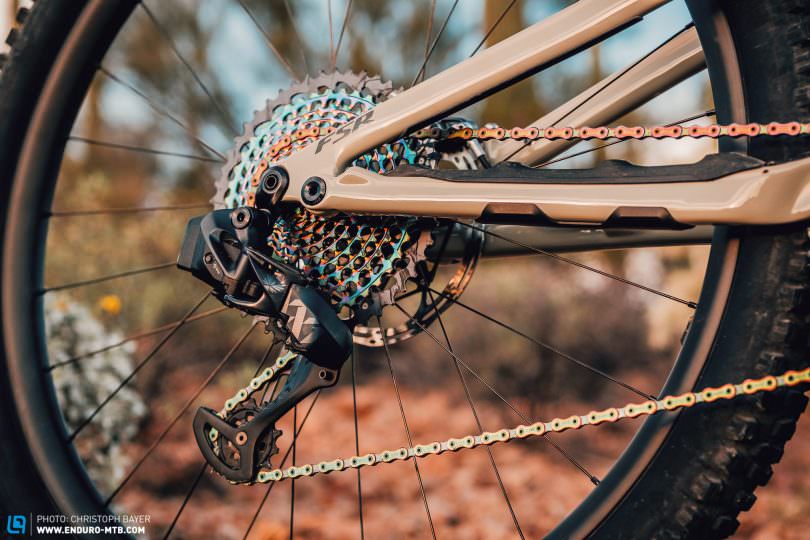How to find the perfect gear ratios for your MTB drivetrain

For many riders, working out gear ratios seems like a Gordian knot; there continues to be a fear of not having enough gear range when switching over to a 1x drivetrain. With a little mental arithmetic, however, you’ll quickly be able to bring light into the dark. We’ll show you, step by step, how to find the right cassette and chainring combination to suit your needs.
With 1x drivetrains, most riders tend to consider the size of the chainring first. “Of course you won’t make it up that climb with a 34T chainring” – that’s probably how most conversations regarding gear ratios with your riding buddies go, but it isn’t quite as simple. The most important aspect of your gear range is the ratio of the easiest gear since that will determine whether or not you be able to ride up that climb or have to push. It basically boils down to three factors: the gear range of the cassette, the size of the chainring and the size of your wheels.
Working out the gear range of your cassette

The gear range of your cassette is a major factor in considering the total usable gear range of your drivetrain. Spec sheets usually mention the largest and the smallest cog of your cassette, where the smallest cog in a 10-42 cassette has 10 teeth and the largest has 42 teeth. You work out the gear range of the cassette by dividing the biggest cog by the smallest, so 42/10 = 4.20 = 420 %. By working out the gear range of your cassette, you will notice that even a small difference in the smallest cog can make a massive difference overall. E*thriteen’s 9-46T cassette, for example, offers a 511 % gear range whereas Shimano’s 11-46T cassette merely offers a 418 % gear range.
| Cassette | Gear range |
|---|---|
| Shimano 11–42 | 382 % |
| Shimano XT 11–46 | 418 % |
| SRAM 10–42 | 420 % |
| SRAM Eagle 10–50 | 500 % |
| Shimano XTR 10–51 | 510 % |
| E*thirteen 9–46 | 511 % |
Ultimately, it doesn’t come down to the number of gears you’ve got, but the gear range of your cassette. For example: switching from a regular 11-speed drivetrain to a 12-speed drivetrain, like a SRAM Eagle or the new Shimano XTR, you technically don’t gain just one but two additional gears. The easiest gear of an Eagle drivetrain paired with a 34T chainring is easier than the easiest gear on a 1×11 SRAM drivetrain with a 30T chainring while the highest gear is the same as a 1×11 drivetrain with a 34T chainring.
Choosing the correct chainring

While the choice of cassette determines the gear range of your drivetrain, you can shift the gearing up and down with the size of the chainring. The smaller the chainring, the easier the lowest gear for climbing; the bigger the chainring, the faster you can go in the highest gear. You can calculate the gearing ratio by dividing the teeth of the chainring with the teeth of the cog on the cassette. We’ll use the following example for clarification.
Let’s say you’ve got a Shimano XT 11-46 cassette and a 32T chainring. With this configuration, the lowest gear has a ratio of 32/46 = 0.696 and the highest gear has a ratio of 32/11 = 2.909. A SRAM 10-42 cassette has a very similar gear range, but with a 32T chainring the lowest gear has a ratio of 32/42 = 0.762 and the highest gear has a ratio of 32/10 = 3.200. If you had to change to 30T chainring on the SRAM drivetrain, you would achieve similar gear ratios as the Shimano XT of 30/42 = 0.714 and 30/10 = 3.000.
We’ve compiled a chart that compares the gear ratios of three common drivetrains with the following gear steps:
SRAM Eagle 10-12-14-16-18-21-24-28-32-36-42-50
SRAM 1×11 10-12-14-16-18-21-24-28-32-36-42
Shimano 1×11 11-13-15-17-19-21-24-28-32-37-46
| Cassette | Chainring | Lowest gear | Highest gear |
|---|---|---|---|
| SRAM Eagle 1×12 (10-50) | 30 | 0.600 | 3.000 |
| 32 | 0.640 | 3.200 | |
| 34 | 0.680 | 3.400 | |
| 36 | 0.720 | 3.600 | |
| 38 | 0.760 | 3.800 | |
| SRAM 1×11 (10–42) | 28 | 0.667 | 2.800 |
| 30 | 0.714 | 3.000 | |
| 32 | 0.762 | 3.200 | |
| 34 | 0.810 | 3.400 | |
| 36 | 0.857 | 3.600 | |
| 38 | 0.905 | 3.800 | |
| Shimano XT 1×11 (11–46) | 30 | 0.652 | 2.727 |
| 32 | 0.696 | 2.909 | |
| 34 | 0.739 | 3.091 | |
| 36 | 0.783 | 3.273 | |
| 38 | 0.826 | 3.455 |
Once you’ve understood the basic principles you’ll easily be able to compare the gear ranges and ratios of different drivetrains. If switching from a 1X11 SRAM drivetrain with 32T chainring to an Eagle drivetrain, you’ll know to fit a 38T chainring for a similarly easy climbing gear. The same applies when you’re upgrading to the new 12-speed XTR drivetrain since its 10-51 cassette is very similar to SRAM’s Eagle drivetrain. If you had to switch to a 1×11 Shimano drivetrain with a 34T chainring, the lowest gear will be a little easier than before, or a little harder than before with a 36T chainring. The same equation obviously applies to the largest available gear too.
The influence wheel size

A 29″ wheel has an outside diameter of 622 mm, paired with a typical 2.25″ tire, the total diameter works out to approximately 735 mm. A 27.5″ wheel has an outside diameter of 584 mm and with the same size tire it works out to approximately 697 mm. As a rule of thumb, to keep the gear ratio similar when changing from 27.5″ to 29″ wheels you would have to go two teeth smaller on the chainring. The distance covered in the lowest gear with a 34T chainring and a SRAM Eagle drivetrain on a 29er is about 1,57 m per crank rotation, and on a 27.5″ bike with a 36T chainring, one crank rotation gets you 1,58 m.
Other considerations

The bigger the gear range of the cassette with the same amount of gears, the bigger the steps between gears. This is particularly important to consider when upgrading your existing 10- or 11-speed cassette for one with a bigger range, which can be a good compromise for some riders. When switching to a larger chainring, be sure to check what the frame manufacturer specifies as the maximum size – your frame might not have enough clearance for a bigger chainring. Bigger chainrings also affect ground clearance, so you might run into problems on bikes with particularly low BBs.
How does all of this translate on the trail?
Which gear ratio is best? There’s no way to answer this question without factoring in the rider and the kind of terrain that you typically ride in. Once you’ve understood the basic gear ratio calculations though, you’ll be able to work out which chainring size best suits your kind of riding.
ENDURO’s editorial team had an internal and we found a clear favourite: most of us would opt for a SRAM Eagle or the new XTR 12-speed with a 32T chainring on a 29er or a 34T chainring on a 27.5″ bike. The same applies to a Shimano drivetrain with an 11-46T cassette, while on a 1×11 SRAM drivetrain most of us would use 30T chainring on a 29er and 34T chainring when running 27.5″ wheels.
Did you enjoy this article? If so, we would be stoked if you decide to support us with a monthly contribution. By becoming a supporter of ENDURO, you will help secure a sustainable future for high-quality mountain bike journalism. Click here to learn more.
Words: Photos: Christoph Bayer, Trev Worsey, Moritz Dittmar








